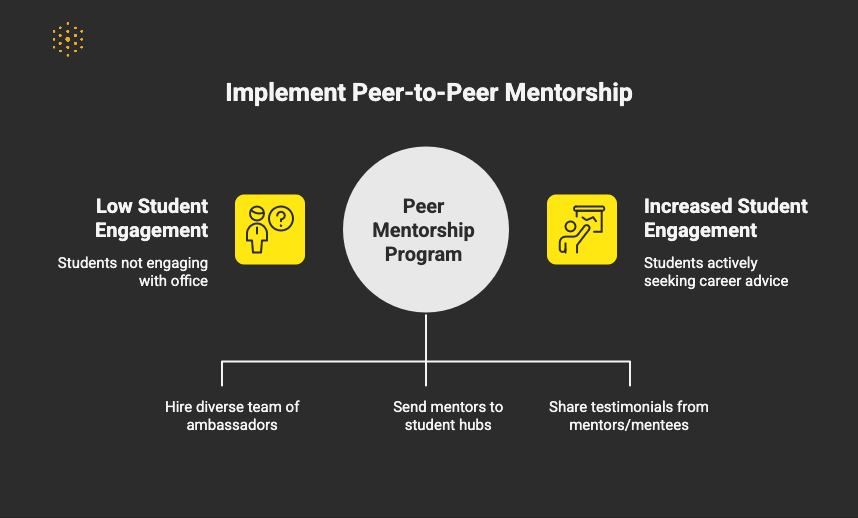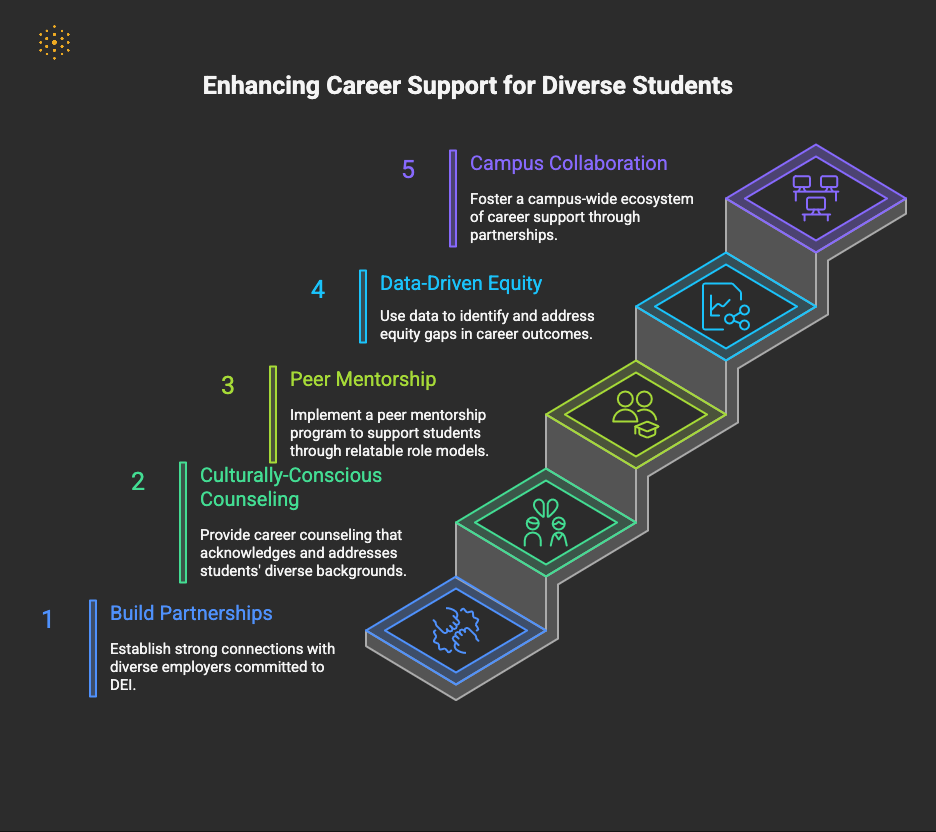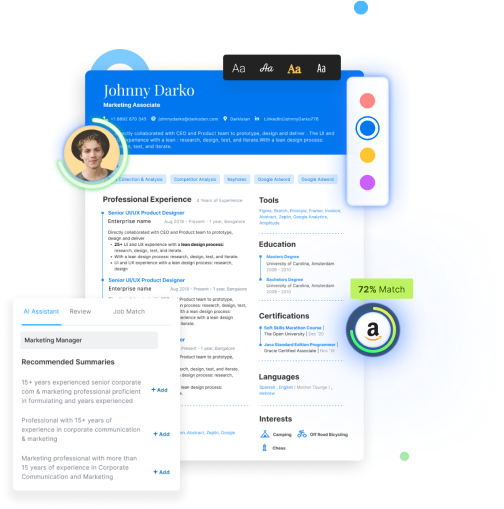What DEI outreach strategies should a career services office implement?
Partner with verified DEI-committed employers, collaborate across campus, deploy peer mentors, use disaggregated data to close gaps, and deliver culturally responsive counseling. Set goals, share progress, and iterate based on outcomes.
Today’s students are more diverse than ever, each bringing their own identity, background, and aspirations into the career center.
But traditional career services models often overlook unique barriers faced by marginalized groups.
For instance, according to NACE's 2023 First-Destination Survey, women graduating with bachelor's degrees earned approximately 20.8% less ($59,778 vs. $72,190) than their male peers.
It's no longer enough to offer generic resources; career centers must intentionally embed diversity, equity, and inclusion (DEI) into their strategies to bridge these gaps.
Here are 5 actionable ways your office can promote equity and ensure every student thrives professionally.
1. Build Targeted Employer Partnerships
Simply inviting diverse employers to campus isn't enough. You need to actively build partnerships with organizations that have a proven commitment to diversity, equity, and inclusion (DEI).
According to a 2023 NACE report, over 81% of employers have DEI initiatives. However, students are savvy; they can spot performative efforts.
The same report highlights that students from underrepresented groups prioritize employers who demonstrate a genuine commitment through their company culture, leadership diversity, and employee resource groups (ERGs).
How to Do It:
- Vet Your Employers: Go beyond their public DEI statements. Ask for data on their diversity hiring and retention rates. Do they have active ERGs? Do they offer mentorship programs for employees from diverse backgrounds?
- Host Niche Events: Instead of a single, massive career fair, host smaller, targeted events. For example, you could organize a "Diversity in Tech Summit" or a "Women in Finance" networking night.
- Showcase Alumni: Connect current students with diverse alumni who are thriving in their careers. These connections provide powerful "social proof" and relatable role models.
Also Read: How to improve FDS response rates?
2. Collaborate Across Campus
Your career services office can't do this work alone. Building strong partnerships with other departments is crucial for creating a campus-wide ecosystem of career support.
How to Do It:
- Partner with Multicultural Affairs: Co-host workshops, share resources, and create a seamless referral process with your Office of Multicultural Affairs, LGBTQ+ Resource Center, and other identity-based centers. They have deep relationships with the students you want to reach.
- Integrate Career into the Curriculum: Work with faculty to embed career development milestones into academic courses. This is particularly effective for reaching students in disciplines where career paths may be less defined.
- Connect with Financial Aid: Collaborate with the financial aid office to create programs that support students in unpaid or underpaid internships, a major barrier for students from low-income backgrounds.
For instance, Pomona College’s Career Development Office (CDO) supports first-generation and low-income (FLI) students through its Smart Start Career Fellows Program.
This initiative includes curated advising, alumni mentorship, professional development seminars, covered travel to industry hubs, and stipends for items like professional attire.
It is promoted through trusted FLI-affiliated channels such as the FLI Scholars group and QuestBridge networks.
Also Read: What are some federal funding options for career centers in the US?

3. Leverage Peer-to-Peer Mentorship
Sometimes, the most trusted messenger is a peer. Formalizing a peer mentorship program can be a game-changer for reaching students who might not otherwise engage with your office.
A study by McKinsey & Company, "Diversity wins: How inclusion matters," reveals that mentorship is a key driver of career progression, especially for women and ethnic minorities.
When students see peers who look like them successfully navigating the career services landscape, it demystifies the process and builds trust.
How to Do It:
- Recruit and Train Diverse Mentors: Hire and train a diverse team of "Career Ambassadors" or "Peer Advisors." These should be students who are well-connected on campus and represent a wide range of majors, backgrounds, and identities.
- Embed Mentors in Student Hubs: Don't wait for students to come to you. Send your peer mentors to where students already are, cultural centers, student clubs, and residence halls, to offer drop-in advising.
- Promote Success Stories: Share testimonials from both mentors and mentees to showcase the program's value and encourage participation.
The University of California, Berkeley's Career Center has a Peer Advisor program where trained undergraduate students provide resume critiques, cover letter help, and general career advice.
By having peers in this front-line role, the center feels more accessible to students who might be intimidated by scheduling a formal appointment with a professional staff member.
Also Read: How is Hiration a better Big Interview alternative?
4. Use Data to Identify and Close Equity Gaps
You can't fix what you don't measure. Using data is essential for understanding where your equity gaps are and whether your initiatives are actually working.
The NACE Class of 2023 First-Destination Survey confirms ongoing disparities: Black and Hispanic bachelor’s graduates earn $59,378 and $60,413, while Asian graduates earn around $82,365.
Meanwhile, gender inequities persist, men are more likely to have full-time employment, and broader early-career data reveals women earn approximately 82 cents for every dollar earned by men (an 18% gap).
Institutional first-destination data can similarly surface these trends on your own campus.
How to Do It:
- Disaggregate Your Data: When you analyze data from appointments, event attendance, and first-destination surveys, break it down by race, ethnicity, gender, first-generation status, and other demographics. Where are the gaps? Are certain groups underrepresented in high-impact practices like internships?
- Set Measurable Goals: Use your data to set specific, measurable, achievable, relevant, and time-bound (SMART) goals. For example, "Increase career counseling appointments among Black male students by 15% over the next academic year."
- Share Your Findings: Be transparent with your campus community about your findings and your goals. This accountability builds trust and can lead to broader institutional support for your efforts.
Also Read: How to help make students great portfolios?
5. Create Culturally-Conscious Career Counseling
Career development isn't culturally neutral. A student's background, identity, and experiences shape their career aspirations, challenges, and decision-making processes. Your counseling approach needs to reflect this reality.
Research shows that students from first-generation and low-income (FGLI) backgrounds often face unique challenges, such as a lack of professional networks and navigating "hidden curriculum" rules of the professional world.
A study published in the Journal of Career Development emphasizes the critical role of culturally competent career counseling in improving career outcomes for minority students.
How to Do It:
- Train Your Staff: Invest in ongoing professional development for your team on topics like cultural competency, implicit bias, and inclusive advising.
- Acknowledge Identity: Create a safe space where students feel comfortable discussing how their identity impacts their career search. This could involve conversations about code-switching, navigating microaggressions in the workplace, or salary negotiation for those facing pay gaps.
- Tailor Your Resources: Develop resources that speak directly to the needs of different student populations. This might include guides on "Navigating the Job Search as an International Student" or workshops on "Building a Professional Network for FGLI Students."
Georgia Institute of Technology's Career Center for instance, offers identity-focused career support through its AuthenTECH initiative.
This program provides curated programming and guidance for specific student populations, including Black students, LGBTQIA+ students, and students with disabilities, acknowledging their unique career journeys and challenges.
Also Read: What are some of the best practices for setting up virtual career treks?

Final Thoughts
Creating a truly inclusive career services office is an ongoing journey, not a destination.
By grounding your diversity outreach programs in data, learning from successful examples, and committing to continuous improvement, you can ensure that every student has the opportunity to achieve their professional dreams.
At Hiration, we support career centers on this journey by automating resume reviews, streamlining personalized interview coaching, and optimizing LinkedIn profiles through AI, freeing your team to provide deeper, more impactful guidance and help every student succeed.
Ready to deliver inclusive career guidance at scale? Schedule a brief walk through with us.
Frequently Asked Questions
-
What are essential DEI outreach strategies for career services?
Focus on 5 areas: targeted employer partnerships, cross-campus collaboration, peer-to-peer mentorship, data-driven equity gap analysis, and culturally-conscious career counseling.
-
How do you build targeted employer partnerships?
Vet employers beyond DEI statements by requesting diversity hiring and retention data and confirming ERGs or mentorship programs. Host niche events and showcase diverse alumni to provide relatable role models.
-
How should career services collaborate across campus?
Partner with Multicultural Affairs and identity-based centers, integrate career milestones into courses, and connect with Financial Aid to support unpaid or underpaid internships.
-
How can peer-to-peer mentorship improve DEI outreach?
Formalize a peer mentorship program with trained, diverse Career Ambassadors embedded in student hubs to offer drop-in advising, resume critiques, cover letter help, and general career advice.
-
Why should you use data to identify and close equity gaps?
Data shows persistent disparities, such as Black and Hispanic graduates earning $59,378 and $60,413, while Asian graduates earn around $82,365. Disaggregate metrics and set SMART goals to target interventions and track progress.
-
What does culturally-conscious career counseling look like?
Train staff on cultural competency and inclusive advising, acknowledge how identity impacts the career search, and tailor resources for different student populations with guides and workshops.
-
What pitfalls should you avoid when partnering with employers?
Avoid performative DEI; "students are savvy; they can spot performative efforts." Go beyond public statements by asking for diversity hiring and retention data and verifying ERGs or mentorship programs.
-
How do targeted niche events compare to a single large career fair?
Replace one massive fair with smaller, targeted events that align communities and employers, such as a "Diversity in Tech Summit" or a "Women in Finance" networking night.
-
Which metrics should you track to evaluate DEI outreach?
Track appointments, event attendance, and first-destination surveys, disaggregated by race, ethnicity, gender, first-generation status, and other demographics to identify gaps and underrepresentation in high-impact practices.
-
How do you support students who face financial barriers to internships?
Collaborate with financial aid to support students in unpaid or underpaid internships and consider stipends for professional attire and covered travel through targeted programs.



